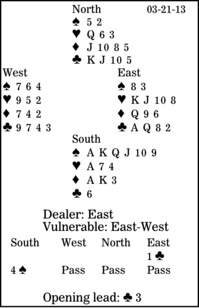Bridge column, March 21: Who was on top with perfect play?

When we are first shown a bridge deal, it is perfect and puts the cards in our hands. Then, usually some mistakes are made -- after all, we are only human.
Sometimes, we can analyze a double-dummy problem. The contract is given and the result calculated, assuming everyone is looking at all 52 cards. At the table, you rarely play double-dummy. However, occasionally it is possible -- as in this deal.
How did South play in four spades? West led the club three (low from length since he had not supported his partner's suit). East took dummy's 10 with his queen and shifted safely to a trump.
South might have started with a takeout double, but he judged it unlikely that his side could make a slam.
Since there were only 12 high-card points missing, declarer could place East with the heart king and diamond queen. South, though, still faced four losers -- two hearts, one diamond and one club -- because he did not have a dummy entry to take the diamond finesse.
Declarer drew trumps, then played three rounds of diamonds. East won and was endplayed. He led the club ace, but South accurately discarded a low heart. Now East, whether he led a heart or a club, had to bring the dummy back to life.
There were other successful lines of play involving a squeeze-endplay on East, but this one was the easiest.
** ** **
COPYRIGHT: 2013, UNITED FEATURE SYNDICATE
DISTRIBUTED BY UNIVERSAL UCLICK FOR UFS

